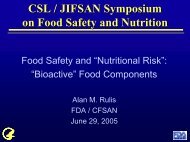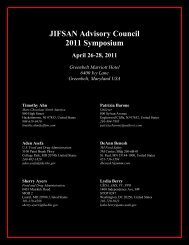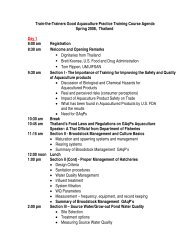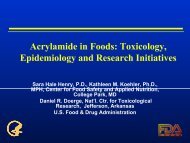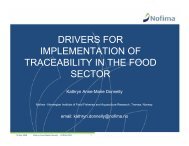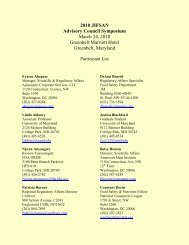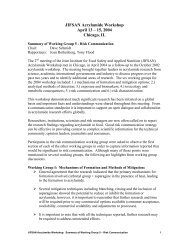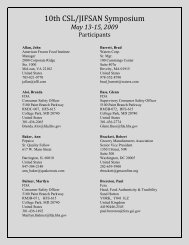Genetics and Dietary Preferences - jifsan
Genetics and Dietary Preferences - jifsan
Genetics and Dietary Preferences - jifsan
- No tags were found...
Create successful ePaper yourself
Turn your PDF publications into a flip-book with our unique Google optimized e-Paper software.
Presenter disclaimer• The research described here has beenfunded mainly by the NIH.• The presenter obtains no personal fundsof any sort from any private company.• Many private companies provideunrestricted <strong>and</strong> research support to theMonell Center.• The current list of these companies:
Monell Corporate SponsorsAFB International Inc.Altria GroupAjinomoto Co., Inc.Avon Products, Inc.Beiersdorf AGCadburyCampbell Soup CompanyThe Coca-Cola CompanyColgate-Palmolive CompanyCoty Inc.Diana IngredientsDiageo, plcDow Advanced MaterialsEstée Lauder Companies, Inc.Firmenich IncorporatedGeneral MillsGivaudan SAGlaxo Smith KlineHeng Yuan Xiang China (Group) Co., Ltd.International Flavors & Fragrances Inc.Japan Tobacco Inc.Johnson & JohnsonKao CorporationKellogg CompanyKerry Ingredients <strong>and</strong> FlavoursKikkoman USA R&D LaboratoryKimberly-Clark CorporationKirin Holdings Company, Ltd.Kraft FoodsL’OrealMarsMcCormick & Company, Inc.Mead Johnson NutritionalsNational StarchNestlé ResearchOgawa & Co. Ltd.PanasonicPepsiCo, Inc.Philip Morris Products S.A.Procter & GambleReckitt Benckiser, plcR.J. ReynoldsRoyal Friesl<strong>and</strong> CampinaSenomyx, Inc.Schering-PloughThe Sugar Association, Inc.Suntory Holdings Ltd.SymriseTaisho Pharmaceutical Co., Ltd.Takasago International CorporationUnilever Research & DevelopmentWm. Wrigley Jr. Company
Overview of Presentation:Why care about flavorWhat is flavorFlavor dissectedSmell - AndrostenoneTaste - SaltChemesthesis - OleocanthalFlavor exp<strong>and</strong>edFuture research directions
Flavor <strong>and</strong> the ChemicalSenses
The SensesVisionHearingTouchSmellTaste
The Senses: Impact of LossVisionHearingTouchSmellTaste
The Senses: Health ImpactVisionHearingTouchSmellTaste
The Senses: Health ImpactVisionHearingTouchSmellFoodTaste
Diseases related to excess food intake• Obesity• Diabetes• Hypertension• Some cancers• Probably many others
What is flavor?SmellTasteChemesthesis – irritation (tingle, burn, cool)
OdorPERCEPTIONareaOdorantsRetronasalTastesTastePERCEPTIONareaIrritants- allskin surfaceMonell Chemical Senses Center
Flavor Drives BehaviorIf it doesn’t “taste” good, people won’t eat it.If it does “taste” good, you can’t stop people fromeating it.
SmellFunctions: Sex, food, warningNobel Prize for ~1000 receptors. Combinatorialcode: each receptor responds to multipleodorants <strong>and</strong> each odorant can activate multiplereceptorsMany different qualities; claim – there arethous<strong>and</strong>s of different smellsDifficult to name – it smells like…Learning relatively more important for liking thantaste
Outside the cell: MucusOlfactoryreceptorsInside the cellBuck & Axel, 1991
OdorantsOdor CodingOdor receptors: In humans ~350 distinct variantsOlfactoryepitheliumGlomeruliMitral cellsLateral olfactorytractHuman: ~ 350Mouse: ~ 1000Olfactory bulbto olfactorycortex2004OlfactoryreceptorsBuck & Axel (1991) Cell. 65:175 - 187
OdorantsOdor CodingOlfactoryepitheliumGlomeruliMitral cellsLateral olfactorytractto olfactorycortexOlfactory bulbOlfactoryreceptors
OdorantsOdor CodingOlfactoryepitheliumGlomeruliMitral cellsLateral olfactorytractto olfactorycortexOlfactory bulbOlfactoryreceptors
Androstenone
Wysocki & Beauchamp, PNAS, 1987
Malnick et al., 2004, red = intact ORF.
Putative <strong>and</strong>rostenone receptorOR7D4Keller et al., Nature, 2007
A fly in the ointment: Effects of experienceWysocki, Dorries & Beauchamp, PNAS
TasteDedicated to food choice: accept or rejectFive basic tastes:Sour - acids: Ripeness?Salty - NaCl, LiCl: Sodium, minerals?Bitter - Alkaloids, peptides, toxins: Poisonavoidance?Umami - Glutamate, aspartate, nucleotides:Protein? Calories?Sweet - sugars, high intensity sweeteners: Caloriesfor plant eating animalsOthers? – fat, calcium, starchInnate responses to many taste stimuli but learningalso occurs
TasteBeginning in 1999 with a paper from Zucker <strong>and</strong> Rybagroup, a series of taste receptors have beenidentified:Sweet: GPCRs – heterodimer T1R2+T1R3Umami: GPCRs – heterodimer T1R1+T1R3Bitter GPCRs - ~25 in humans; dimerize?Sour: Ion channel(s) – PDK, ASIC, others?Salt: Ion channel(s) – ENaC, TRP, others?
Major Discoveries in Taste ReceptorsLi et al, 2002;Nelson et al., 2002.
Multiple Regions of T1R2+T1R3 are Required forEffective Interaction with Different Sweet CompoundsThe sweet receptor has six distinct lig<strong>and</strong> binding sitesT1r2 & T1r3 Amino Terminal DomainsSugars, aspartame,small molecule sweetenersT1r3 C-Rich RegionBrazzein, monellinT1r3 Transmembrane Regioncyclamate, lactisoleT1r2 Transmembrane RegionperillartineATDsT1r2+T1r3 HeterodimerR. Margolskee
Salt
Salt, … the primordial narcotic**Multhauf, RP, Neptune’s Gift, Baltimore: The Johns Hopkins University Press, 1978, p. 4.
Too much?
The Problem: Once Americans reach theirfifties, the risk of developing high bloodpressure over the remainder of the lifespanis estimated to be 90% even for those withhealthy blood pressures. It has beenestimated that reducing sodium intakescould prevent more than 100,000 deathsannually <strong>and</strong> save billions in medical costs.
Recommendations in the past:1969: The first statement from the U.S.government:First: at risk populationsLater: all U.S. populationSince 1968, more than 18 national <strong>and</strong>international government <strong>and</strong> medical bodieshave concurred.Results to date: NO EFFECT!
Salt is everywhere in the U.S. food supply <strong>and</strong>most is added by others
Two potential strategies:Change the stimulus – or – Change the person
Salt taste mechanismsThe identity of the human salt receptor - newinformation <strong>and</strong> remaining puzzles• Stimulus specificity:– NaCl <strong>and</strong> LiCl only purely salty substances known.– This suggests a very specific mechanism.• Animal models:– Neural responses to NaCl are inhibited by the diureticamiloride.– In 2010 two research groups proved that one component ofthe salt receptor mechanism involves an epithelial Nachannel (ENaC).
Epithelial Na channel (ENaC)
Salt taste mechanisms• One component is an ENaC*• Implications:- Salt taste substitute through thismechanism unlikely due to specificity- Salt taste enhancer possible*Bosak et al., 2010; Ch<strong>and</strong>rashekar et al., 2010
Salt taste mechanisms• An ENaC is not the entire answer.• A second less specific salt taste mechanismalso exists.• This may account for several of the othertaste attributes of salt such as mouthfeel,fullness, lowered bitterness <strong>and</strong> overallbalance.• This mechanism is unknown.
Vilhjalmur Stefansson
Decreasing Na intake is followed bydecreased salt preferenceExperimentalPre dietLow Na dietNaCl Concentration in crackers (%)Bertino , Beauchamp & Engelman, AJCN
Recommendation of the IOM Committeeon Strategies to Reduce Sodium Intake:FDA set m<strong>and</strong>atory st<strong>and</strong>ards to requirefood <strong>and</strong> restaurant industries togradually reduce the salt content of theirproducts.
Stepwise process for achieving final st<strong>and</strong>ards for the addition of salt to foods
Salt intake across cultureshypertension % prevalence403020100.1YanomamaXingu1Rambugu& NdoriAsaro1065 mmol1008 gr NaCl3200 mg Na1000sodium excretion mmol/dayFrom Beard, 2004
Human adults do not compensateBeauchamp et al., JAMA
Chemesthesis/IrritationChemical skin senseStimuli: CO 2 , menthol, hot peppersPain, heat, cooling, tingle, itch etcReceptors: TRP ion channels - originallydiscovered as temperature sensitiveWhy do people like these in foods <strong>and</strong> beverages?
The Ion Channels of NociceptionNeuronalmembraneNTransient ReceptorPotential Channels(TRPs)CNCAcid SensingIon Channels(ASICs)Acid - TRPV1Heat - TRPV1, TRPV2Cold - TRPA1Capsaicin - TRPV1Mustard oil - TRPA1Membrane stretch - TRPV2Acid - DRASIC
Oleocanthal
IbuprofenA widely used anti-inflammatory drugRelieves painIn some ways mimics aspirin withoutall of the side effectsLong-term consumption has beenreported to reduce the risk of heartdisease <strong>and</strong> some forms of cancer<strong>and</strong> to delay the onset ofAlzheimer’s disease“Tastes bad” – Exclusive throat irritant
Profile sheet used for sensory assessment of olive oil
Throat stinging compound(-)-decarbomethoxy-dialdehydic ligstroside aglyconeHOO1OCHOCHOOleocanthal(oleo = olive; canth = sting; al = aldehyde)
OleocanthalA potent anti-inflammatory compoundfound in many extra virgin olive oilsActivates receptors in throat onlythrough TRPA1; very specific.In humans TRPA1 is expressed inthroat but not the mouth, hence thespecificityIn vitro, is effective against severalcancer cell models <strong>and</strong> pathwaysinvolved in Alzheimer’s disease
Health-beneficial effects of the Mediterranean dietMediterranean dietOlive oilPolyphenolsOleocanthalOleocanthal
Flavor Exp<strong>and</strong>ed:“Taste” throughout thebody
The Tongue’s Taste Cells are the InitialChemosensors of the Alimentary TractThere are also Taste Cells in the Gut!• Multiple taste signaling proteins are found in the gut• And the pancreas• In specific gut endocrine cells <strong>and</strong> brush cells• Integrate physiological responses to digestionR. Margolskee
The Tongue’s Taste Cells are the InitialChemosensors of the Alimentary TractThere are also Taste Cells in the Gut!R. Margolskee
ProspectsTargeting gut taste cellsNew secretagogues to promote GLP-1releasePotential new targets for treatment ofobesityPotential new targets for modulatinggut motilityR. Margolskee
Flavor Receptors Elsewhere:Functions?Bitter taste receptors in the upper noseBitter taste receptors in the smooth muscle of the lungSweet taste receptors in the brain <strong>and</strong> pituitary gl<strong>and</strong>
Flavor Receptors Elsewhere:Functions?Bitter taste receptors in the upper noseBitter taste receptors in the smooth muscle of the lungSweet taste receptors in the brain <strong>and</strong> pituitary gl<strong>and</strong>Sweet taste <strong>and</strong> olfactory receptors in sperm
Sperm <strong>and</strong> egg meet“Smell”Smell receptors: Spehr et al., Mol CellEndocrinol. 2006, 250.Taste receptors: Kiuchi et al., Cytogenet.Genome Res. 2006, 115.“Taste”
Some Research Needs- What is the nutritional importance of genetic variationin flavor receptors?- What nutritional roles are played by flavor receptorsoutside the nasal <strong>and</strong> oral cavities?- How does genetic variation interact withenvironmental variation to influence nutritionalphenotyes?- Are epigenetic modifications in flavor receptors ofnutritional significance?- How can our new <strong>and</strong> growing knowledge of flavorperception mechanisms <strong>and</strong> functions be translatedinto practical applications to reduce incidence <strong>and</strong>consequence of human diseases?
Thank youMonellChemicalSensesCenterwww.monell.org




